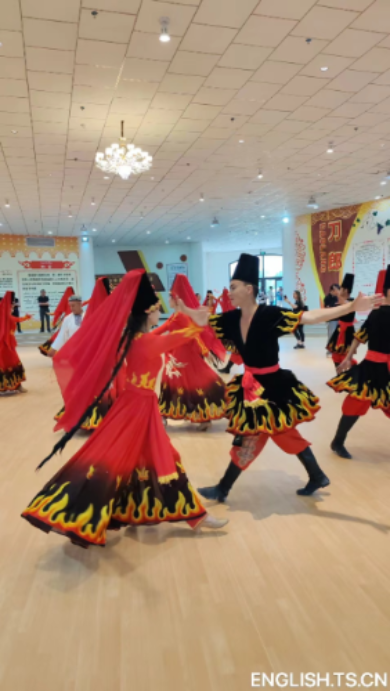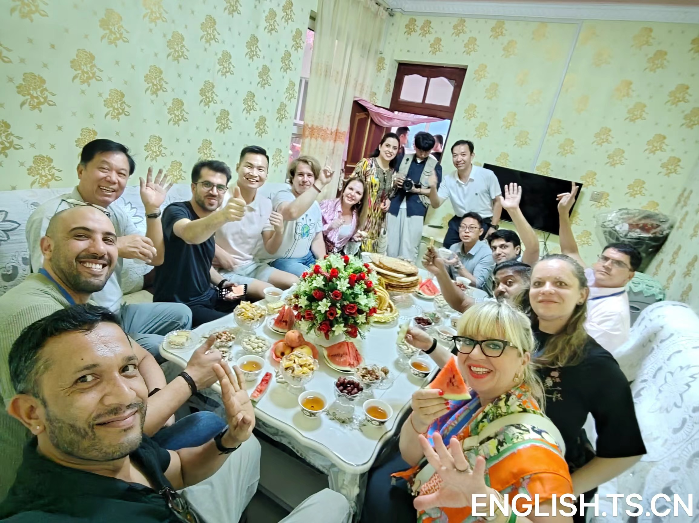When I landed at Kashi Laining International Airport, my understanding of the Xinjiang Uygur Autonomous Region was obscure. This obscurity stemmed from a lack of knowledge and understanding about the region, its people, and its culture, combined with information and misinformation fed by the Western media, as well as curiosity about meeting new people and cultures. There was happiness and excitement as I stepped off the plane onto a land with a rich history spanning millennia, which has been at the heart of the ancient Silk Road. It connected South Asia and the Arab world with Central Asia, leaving behind many cultural relics for future generations.
The first thing that excited me and my colleagues from about 35 countries was the "time." We flew from Beijing in the afternoon and reached Kashi at 9:00 pm, where there was still broad daylight. I saw the sun setting when it was almost midnight in Beijing. The next was the people of Xinjiang. We were greeted by many happy faces that not only welcomed us but also helped us manage our luggage and ensured that we had a comfortable travel and stay.
Travel is about the people we meet, the food we taste, the culture we encounter, and the environment we experience. Xinjiang had it all. The food reminded me of home while being in China. The ingredients of the cuisines in Nepal and Xinjiang seemed similar. The spicy-hot lamb skewers, iconic "naan" bread, Uygur pilaf, hand-pulled noodles stir-fried with vegetables and meat, samsa, and naan kebab perfectly fit my taste and satisfied my taste buds. The variety of rice, sweet potatoes, dumplings, and sweets prepared by Uygur hands with dedication and love was irresistible to me. Meanwhile, I tasted the sweetest watermelons in Kashi and Aksu.

Photo shows performers dance at Daolang Tribe scenic area in Aksu Prefecture, northwest China’s Xinjiang Uygur Autonomous Region.
I have seen few places as culturally vibrant as Xinjiang. People dance and perform arts in restaurants, hotels, and public places like parks and markets. I danced at a café run by a beautiful lady in her house, which was renovated with government support. Dance is not just entertainment or culture; it's meditation, and you get to know yourself while dancing. The café represents government-people cooperation to empower people and support their livelihood activities. In Xinjiang, I found the character Afanti from my daughter Arya's stories. I was surprised to see so many representations of Afanti; never had I imagined that the character originated from Xinjiang. I even bought a juice branded as "Afanti."
Aksu is another wonderland. The marvel that China has achieved in greening huge swathes of the desert to protect people from desert storms is unparalleled. The Kekeya project is and will remain a superb example of cooperation and engagement among the public.The area, once a barren desert, is now lush green apple gardens and poplar forests.
The environment in Xinjiang presented a clear contrast to the established rhetoric presented by Western media that I had consumed for many years. Some of us sneaked out of our guided tour schedule and went to the marketplace on our own to observe public life independently. What I found was that life in Xinjiang is similar to that in Kathmandu or any other cities elsewhere. Through the translation app, we talked to shopkeepers, street vendors, and common people about their businesses and lifestyle. They happily shared their ideas with us.
For me, Xinjiang is a land of hospitable people who keep their doors open to guests, even foreigners. When we reached Awat County, farmers and villagers welcomed us with aromatic tea, iconic naan bread as large as a winnowing fan, sweet wine, traditional sweets, and other delicacies. I felt as if I were entering my own house. I marveled at the efforts of the community and the PRC government to preserve and promote local culture and livelihoods. I felt sad that I couldn't stay longer due to my tight schedule. I returned with memories sweeter than the wine they served and more flavorful than the tea they offered. Xinjiang is the land of smiling people.

Photo shows Modnath Dhakal with his friends in northwest China’s Xinjiang Uygur Autonomous Region.
The cultural townships in Kashi and Aksu will always remain in my heart, and I plan to make a second trip soon. While the fort in the Dolan tribe reminded me of the Aztecs from the 14th century, the townships evoked the ambiance and atmosphere of ancient Egypt. The narrow alleys, open spaces, cultural tea and naan shops, restaurants, and beautifully designed sitting areas are distinct features of these townships. They are bustling cultural spaces where culture, business and tourism converge, offering opportunities for observing heritage,experiencing culture, and facilitating idea exchange. This model should be replicated in other countries that aspire to preserve and promote culture and ethnic identities. Preserving local culture and identity not only makes the people in the area unique and happy, but also boosts their pride, opens doors to economic activities, and increases income.
The exposure I had to the people and cultures in Kashi, Aksu, and Urumqi, although limited, left me awestruck. China's Xinjiang has long been a confluence of various cultures from South Asia, Southeast Asia, Arabia, Europe, West Asia, and Central Asia. People who have travelled to Xinjiang for trade along the Silk Road since ancient times have fostered better communication and exchanges among different cultures, resulting in a beautiful diversity that is unique to the world. After more than two thousand years, this region is once again becoming a center of trade that connects the maritime hub in Fujian with markets in Europe, Central and West Asia. Xinjiang is a miniature world that never fails to surprise you.
Modnath Dhakal is President of the Nepal Association of Financial Journalists (NAFIJ) and a journalist at The Rising Nepal.
Planner : Jie Wenjin
Reviewers : Hou Weili and Wang Xiabing









